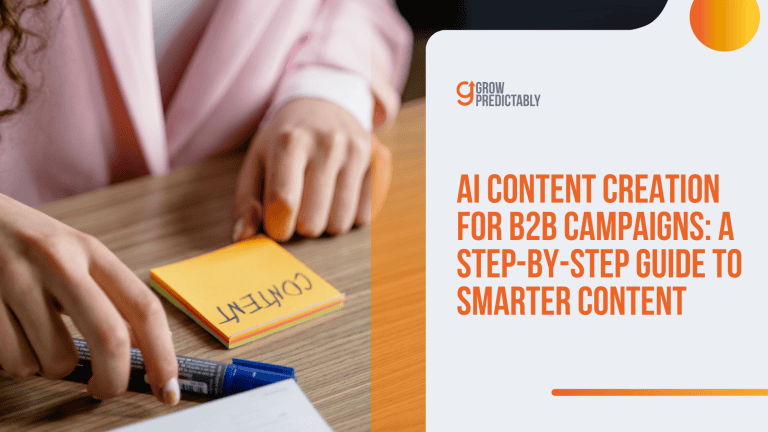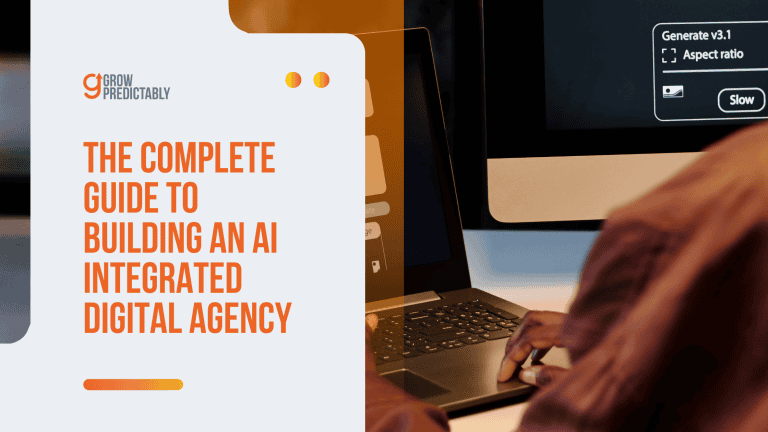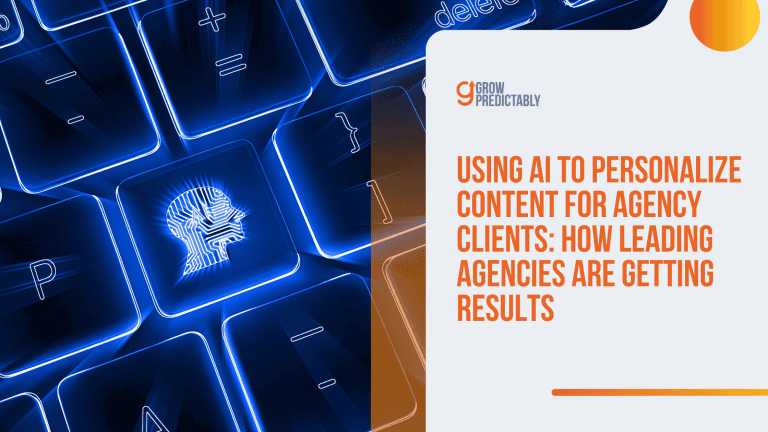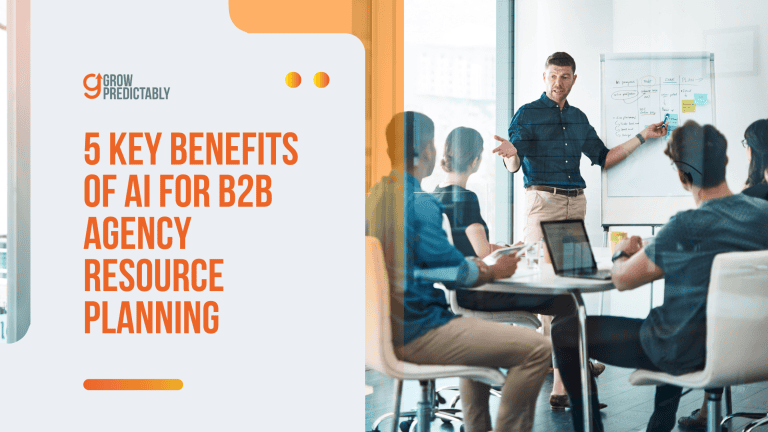The Future of AI in Digital Marketing Agencies: A How-To Guide for 2025 and Beyond
Think the future of AI in digital marketing agencies is just about automation?
That’s where most go wrong.
This guide flips the script by focusing on what actually drives real results: training your team, selecting low-lift high-impact tools, and showing clients the wins.
Skip that, and you’ll waste hours on tools your team won’t use.
The good news?
You only need to tweak what you’re already doing.
AI’s transformative impact on digital marketing includes applications in data analysis, workflow optimization, and content creation, enhancing operational efficiency and improving marketing strategies.
Want to find the one process in your agency that artificial intelligence can fix today?
This guide takes you through eight must-do steps to get ahead with AI.
By the time you finish reading, you’ll have a practical plan to transform your agency.
But here’s the thing – you won’t have to wait until the end to start seeing results.
Let’s start by finding out where your agency stands on the AI readiness scale…
1. Assess Your Agency’s AI Readiness and Define Clear Goals
By 2025, agencies using AI effectively will lead their niches.
Do you aim to be among them?
Many marketing agencies face a crucial moment.
Some will leap forward with AI, while others may fall behind.
It’s important to evaluate your current AI engagement to understand your position.
Start by examining how you use AI across different functions like analytics, content creation, and customer experience management.
Incorporate predictive analytics to enhance your marketing strategies by forecasting customer behavior, optimizing campaigns, and personalizing customer experiences.
Determine how comfortable your team is with adopting new technology, interpreting data, and making data-driven decisions.
Additionally, assess your ability to track real-time campaign performance, manage resources effectively, and evaluate returns on your technology investments.
Enhancing Tool Effectiveness
Conduct a thorough review of your existing tech infrastructure.
Identifying areas where AI can integrate and enhance performance is crucial.
Leveraging historical data can significantly improve the performance of AI tools by providing insights into past trends and behaviors.
This data helps in fine-tuning algorithms and making more accurate predictions.
If you’re spending substantial time on manual reporting, automating tasks with AI tools like Google Analytics 4 can significantly boost efficiency.
- Evaluate Current Tools: Identify each tool’s roles and efficacy.
- Pinpoint Gaps: Highlight areas where AI could fill in or optimize.
- Implement and Test: Introduce AI tools incrementally and measure their effectiveness.
Streamlining your tech processes with AI not only saves time but also enhances overall operational efficiency.
Cultivating Team Growth and Adaptability
Technology is just one part; your team is the other crucial component.
Marketing teams can significantly enhance their operations with AI tools, improving efficiency, streamlining workflows, and supporting strategic decision-making.
Focus on understanding each member’s skill set and readiness to learn.
Curiosity and willingness to adapt ensure your team can efficiently engage with AI tools.
Encourage continuous learning by providing opportunities for skill enhancement and embracing a culture that values growth and adaptation.
- Skill Assessment: Regularly check team comfort with existing technology.
- Encourage Learning: Provide resources and training opportunities.
- Foster Curiosity: Create a supportive environment for questions and exploration.
By nurturing a team that is both skilled and adaptable, you lay a solid foundation for successful AI integration.
Planning for Future Client Expectations
Anticipating future client demands positions your agency for ongoing success.
Looking forward to 2025, consider what capabilities and services clients will seek.
Understanding market trends will be crucial in forecasting future events and adjusting your strategies accordingly.
Whether it’s faster data outputs or more nuanced personalized services, aligning your preparations with future trends will be key.
- Trend Analysis: Keep an eye on emerging industry trends.
- Client Feedback: Regularly gather and analyze client needs and expectations.
- Strategic Roadmap: Develop plans that incorporate both current needs and future predictions.
Preparing for the future ensures your agency remains relevant and competitive as client needs evolve.
2. Identify and Prioritize AI Use Cases That Deliver Maximum Impact
Rushing into AI without a clear strategy often leads to wasted efforts and missed opportunities.
But when done right, AI can transform agency operations, saving time while enhancing client outcomes.
For instance, integrating AI-generated content can streamline content creation, allowing agencies to focus on more strategic tasks while maintaining authenticity and quality.
Imagine reducing routine tasks by 15 hours a week while delivering superior results.
Here’s how to start strategically and effectively.
Finding Your Perfect AI Starting Point
Identify the tasks that sap your team’s time but don’t require creativity.
Start by pinpointing routine, repetitive tasks that can be automated, freeing up your team to focus on more strategic activities.
Automating routine tasks not only enhances efficiency but also allows your team to dedicate more time to high-value, strategic initiatives.
- Routine Tasks Identification: Make a list of daily tasks that are time-consuming and don’t demand human creativity.
- AI Suitability Assessment: Evaluate which of these tasks can be automated effectively with current AI tools.
- Task Prioritization: Focus on automating tasks that are high-effort but add low value when done manually.
By enhancing workflow efficiency with AI, such as automating data processing tasks, you can achieve a smoother, error-free operation that saves time.
Smart Applications of AI
To make AI impactful, select areas where it can bring significant improvements.
Lead scoring, content creation, and campaign analysis are prime candidates.
Employ tools like Salesforce Einstein for lead qualification, Jasper for content support, and Albert.ai for campaign performance analysis.
- Lead Qualification & Scoring: Use tools that analyze behavioral patterns to rank leads, cutting response times significantly.
- Content Creation Support: Adopt AI that aids in research, drafting, and creating social media posts to boost content output while maintaining quality.
- Campaign Performance Analysis: Utilize AI to spot trends and suggest improvements, enhancing ad performance substantially.
These applications not only optimize processes but also boost client deliverables, creating a better overall agency experience.
Making Smart Choices: Your Decision Guide
When selecting AI projects, apply a structured criteria approach.
Prioritize initiatives by assessing the time saved, impact on client results, setup complexity, team readiness, and cost-benefit ratio.
- Impact Assessment: Evaluate AI projects based on expected benefits and ease of implementation.
- Resource Management: Balance potential gains against the required investment and effort.
- Success Metrics: Define clear metrics to evaluate each project’s success, ensuring the best allocation of resources. Utilize AI-driven tools to derive actionable insights from data analysis, which can help identify trends, enhance client reporting, and optimize marketing strategies.
💡 Pro Tip: Start with projects offering high impact but low complexity.
This strategy minimizes risk while showcasing AI’s potential, gaining stakeholder support for future initiatives.
3. Build or Upskill Your Team for AI-Driven Success
Think your team needs degrees in coding to excel with AI tools?
Not even close!
Let’s discuss how to prepare your team for the AI revolution without getting lost in technical jargon.
Integrating ai powered tools can significantly enhance your team’s efficiency and productivity.
These tools assist in content creation, optimize workflows, and improve client interactions, allowing your team to deliver high-quality output without the extensive manual labor traditionally involved.
Start With a Simple Skills Check
Begin by pulling your team together for an assessment to map out everyone’s familiarity and comfort with AI tools.
You don’t need complex frameworks—start with straightforward conversations to identify:
- AI Tool Exposure: Who’s already experimenting with AI tools?
- AI-Needed Tasks: Which tasks within your team could be improved with AI assistance, such as analyzing customer behavior to gain insights into consumer preferences and behaviors?
- Barriers to Progress: Where do team members feel stuck or challenged when it comes to AI?
These discussions will help identify your starting point and areas needing the most focus, without overwhelming your team.
Create Learning Paths That Make Sense
Tailor learning journeys to fit different roles and their specific AI skill needs.
Each team requires unique abilities to leverage AI effectively:
➡️ For Content Teams:
- AI Writing Tools: Introduce basic AI tools to aid content creation.
- Prompt Crafting: Develop skills in creating effective AI prompts.
- Content Optimization: Learn techniques to enhance SEO and engagement.
➡️ For Data Teams:
- AI Analytics Basics: Equip teams with foundational AI analysis skills.
- Pattern Recognition: Focus on identifying trends and insights.
- Reporting Automation: Master automation of routine reports.
➡️ For Client-Facing Teams:
- Explaining AI Benefits: Train teams to clearly articulate AI’s advantages.
- ROI Demonstration: Practice showing how AI contributes to client ROI.
- Client Reporting: Enhance skills in using AI-driven tools to streamline and simplify client reporting, providing actionable insights efficiently.
By tailoring training, each department can build competency in relevant areas, maximizing the impact of AI across your agency.
Make Learning Fun and Natural
Create an environment where learning AI feels natural and enjoyable.
Engagement and progress multiply when learning is integrated organically into the routine.
- AI Play Sessions: Create weekly sessions for casual AI exploration and experimentation, incorporating insights from customer service interactions to tailor the experience and enhance engagement.
- Team Celebrations: Share successes and breakthroughs in team meetings to build morale.
- Rewards and Mentorship: Offer incentives for AI innovations and pair new learners with experienced users.
By making AI learning enjoyable and rewarding, you reinforce a positive learning culture and accelerate your team’s growth in using AI effectively.
Watch for Hidden Champions
Keep an eye out for team members who naturally engage with AI—these individuals often become your internal champions.
- Excited Innovators: Look for those who get excited about exploring new AI tools.
- Peer Teachers: Identify team members who enjoy helping others learn and grow.
- Creative Adopters: Recognize those who find innovative ways to incorporate AI into projects, such as leveraging marketing automation to streamline workflows and automate campaigns.
Nurture these champions by supporting their learning and providing them with opportunities to lead AI initiatives within your agency.
⚡ Power Tips:
- Start small and celebrate each achievement—recognize all progress.
- Emphasize practical skills over theoretical knowledge.
- Allow team members to learn at their own pace, integrating learning with real project needs.
🎯 Next Step Challenge: Encourage each team member to choose one AI tool to master this month. Track and celebrate their progress together.
Remember, your team doesn’t need to become AI experts overnight. Focus on small, consistent steps—progress over perfection. This approach leads to significant transformations, empowering your team and enhancing your agency’s capabilities.
4. Integrate AI Tools Seamlessly Into Your Agency Workflow
Time is critical as agencies rush to incorporate AI into their workflows effectively.
The key to success is precise integration—done incorrectly, AI can cause more issues than it resolves.
Let’s ensure your agency takes the right steps to realize AI’s full potential by leveraging emerging AI technologies.
This will allow your team to spend less time on mundane tasks and more time on creative strategy.
Mapping Your Current Workflow Sweet Spots
The first step in seamless AI integration is identifying the areas in your workflow where AI can offer substantial benefits.
Start by pinpointing natural entry points for AI in your daily operations to optimize efficiency and creativity.
- Client Onboarding Paperwork: Automate data entry and initial communication tasks to save time and reduce errors.
- Campaign Reporting Cycles: Streamline report generation with AI to provide quicker insights and free up time for strategic planning.
- Content Creation Bottlenecks: Utilize AI to assist in drafting and editing, especially for content tailored for various social media platforms, allowing your content team to focus on creativity.
- Data Analysis Tasks: Apply AI tools to handle data collection and initial analysis, speeding up the decision-making process.
💡 Quick Win: Target processes that consume substantial time but require minimal human creativity to implement AI solutions effectively.
Connecting Your Tech Stack
Integrating AI seamlessly means ensuring compatibility with your existing technology.
This step is crucial in avoiding disruptions and enhancing your current systems.
- CRM and AI Integration: Link customer relationship management data to AI analysis tools to unlock deeper insights and automated solutions.
- Content Management System Links: Connect your content systems with AI writing assistants to boost productivity without compromising quality.
- Automated Tool Handoffs: Create workflows where AI tools automatically pass data to the next system, ensuring a smooth operational flow.
- Marketing Tools Compatibility: Ensure that your AI marketing tools are compatible with your existing technology stack to streamline workflows, improve reporting capabilities, and unify data from multiple sources.
Remember: Start small, test thoroughly, and scale the integrations that prove most effective and beneficial.
Privacy First, Always
Protecting privacy is paramount in any AI integration.
Ensure your systems are compliant with current privacy standards and ai related laws, which protects both your agency and your clients.
- AI Tool Verification: Confirm all AI tools align with current privacy laws, ai related laws, and industry standards.
- Data Handling Protocols: Develop and implement clear procedures for managing and processing data.
- Client Consent: Ensure clients are informed and consent to the use of AI in relevant processes.
- Compliance Documentation: Keep thorough records of all compliance steps to ensure transparency and accountability.
Creating Your Feedback Loop
Regular evaluation ensures that AI tools optimally benefit your agency.
Establish ongoing checkpoints and reviews to maintain performance and justify investments.
- Weekly Check-Ins: Conduct regular team discussions to assess AI tool usage and resolve any issues promptly.
- Monthly Reviews: Evaluate effectiveness monthly, adjusting processes to enhance tool performance and client satisfaction.
- Quarterly ROI Assessments: Analyze return on investments to ensure AI tools contribute positively to your agency’s goals and improve client satisfaction.
Sample Integration Timeline:
➡️ Week 1: Identify and select one workflow for improvement.
➡️ Week 2-3: Deploy AI tools in a test environment to gauge performance.
➡️ Week 4: Train staff and document refined processes.
➡️ Week 5+: Scale the successful implementations, monitoring for continuous improvement.
⚠️ Common Pitfalls to Avoid:
- Trying to automate everything at once can lead to overwhelm—focus on one aspect at a time.
- Skipping team training leaves gaps in understanding and efficiency.
- Failing to set clear success metrics makes it difficult to measure progress and justify tools.
- Neglecting process documentation hinders replication and scaling.
🎯 Your Next Steps:
- Identify your top 3 time-consuming tasks.
- Choose one for a 2-week AI pilot.
- Document results and insights gained from the trial.
- Celebrate achieved milestones and learnings with your team.
Remember, AI is not meant to replace your team’s expertise but to amplify it.
It’s like adding a proficient team member focused on routine tasks, enabling your skilled human talent to concentrate on strategy and creativity.
Always ask, “Does this integration simplify our work or merely change it?” “Can my team clearly communicate the benefits to our clients?” “Are we tracking the right performance metrics?”
These questions help keep your AI integration on the right track.
Aye aye!
5. Measure, Optimize, and Prove AI’s ROI to Clients
Are you ready to transform your AI investments into tangible client successes?
Showcasing the value AI delivers in quantifiable terms can turn client meetings into dynamic discussions powered by data-driven insights, ultimately driving business growth.
Imagine beginning your next meeting with real-time data demonstrating how AI enhanced campaign performance by 40%.
This is the compelling power of accurately measuring AI’s ROI.
Focus on What Clients Really Care About
When communicating AI’s impact, prioritizing outcomes that resonate with client priorities is key.
Sidestep technical jargon and hone in on these metrics that truly matter:
- Campaign Performance Gains: Highlight increases in conversion rates and engagement scores that clearly demonstrate enhanced campaign effectiveness. Emphasize how AI optimizes ad campaigns, leading to better performance and more efficient spending.
- Time Saved: Showcase the reduction in hours spent on mundane, repetitive tasks, allowing for reallocation to higher-value activities.
- Cost Reductions: Illustrate savings in campaign management costs attributable to AI efficiencies.
- Customer Retention Improvements: Demonstrate how AI fosters stronger customer relationships, boosting retention rates.
- Revenue Growth: Link AI implementations directly to enhanced revenue growth, showing clear financial benefits.
💡 Quick Win: Start tracking before-and-after metrics for a single AI tool today. Even minor successes build substantial client confidence.
Building Your Measurement System
A structured approach to measurement can powerfully demonstrate AI’s value to clients.
Establishing a robust system is critical to conveying meaningful insights by providing data driven insights.
Pick Your Core Metrics
Select key metrics that align with client goals and provide clear, impactful insights:
- Choose 3-5 Key Metrics: Focus on metrics that directly impact client objectives, including customer engagement metrics to enhance marketing strategies.
- Outcome-Oriented Focus: Prioritize outcomes over mere activities to assess real impact.
- Track Short and Long Term: Monitor both quick wins and sustained trends for comprehensive insights.
Set Up Your Dashboard
Creating visual representations of data via dashboards enhances comprehension and engagement:
- Visual Tools: Use platforms like Power BI or Tableau to present data visually, especially in the context of digital advertising. These tools can help streamline processes and enhance capabilities in various aspects of digital advertising.
- Client-Specific Views: Tailor dashboards to each client’s unique KPIs and needs.
- Real-Time Updates: Integrate real-time updates to provide current insights.
Review and Optimize
Consistent evaluation ensures tools remain effective and improvements are ongoing:
- Weekly Metrics Checks: Regularly review performance metrics to spot trends and issues.
- Fine-Tuning: Adjust AI tools and ai algorithms based on feedback and results.
- Documentation: Keep thorough records of improvements for impactful client presentations.
Making ROI Clear to Clients
Clear communication of ROI is crucial. Use simple, engaging visuals to convey key points:
- Show, Don’t Tell: Create reports that vividly display money saved, time recovered, and performance improved, enhancing client reporting.
- Pro Tip: Develop an “AI Impact Scorecard” for each client, updated monthly, to showcase continuous progress and achievements.
Visual, straightforward client reporting helps clients grasp AI’s value quickly and effectively, reinforcing your agency’s role as a strategic partner in their success.
Using these strategies, your agency can transform AI investments into clear client wins, building trust, and enhancing long-term partnerships.
6. Navigate Ethical, Privacy, and Differentiation Challenges
The digital marketing landscape is evolving, and your agency’s reputation increasingly relies on how you manage AI ethics, privacy, and data practices.
Handling these aspects well can turn potential challenges into a competitive edge.
Here’s how to approach this critical area with confidence and integrity.
Build Trust Through Ethical AI Practices
Trust is fundamental when using AI, and establishing ethical practices is key to fostering this trust.
Start with these essential steps to ensure your AI applications are reliable and unbiased:
Check Your AI Tools: Conduct regular bias assessments to guarantee fairness in your AI systems.
Document data sources and decision-making processes to maintain transparency in how AI derives conclusions.
Test outputs across different demographic groups to ensure consistent, equitable performance.
Such diligence demonstrates your commitment to ethical standards and helps avoid unintended biases that could harm client relationships.
Create Clear Client Guidelines
Clear communication is crucial for building client trust regarding AI usage.
Develop guidelines that are straightforward and accessible:
- Plain-Language Explanations: Articulate your AI usage in simple terms so clients understand its purpose and process.
- Data Handling Protocols: Establish and share concise protocols for data management, including how consumer data is collected, stored, and used. This reassures clients about the responsible handling of their data.
- Opt-In/Opt-Out Simplicity: Provide clear, uncomplicated options for clients to opt in or out of AI data usage.
These efforts make AI interactions transparent and give clients confidence in your ethical approach to using their data.
Stand Out Through Transparency
Transparency in your AI practices can differentiate your agency and showcase your commitment to responsible operations:
- Share Ethical Practices Upfront: Be proactive in communicating your ethical AI policies and practices to clients, including how your reputation management strategies help maintain and enhance their online presence.
- Visible Commitment: Make your dedication to ethical AI usage and privacy protection a prominent aspect of your brand.
- Privacy as a Selling Point: Highlight how protecting client privacy is integral to your operations and use it as a unique selling proposition.
💡 Quick Tip: Maintain a running log of AI decisions and their impacts. This not only builds client trust through transparency but also helps identify potential issues early, allowing you to address them proactively.
By focusing on ethical usage, clear guidelines, and transparency, your agency can navigate AI-related challenges effectively, establishing a reputation for integrity and excellence in a rapidly changing digital landscape.
7. Solving Common AI Adoption Hurdles
Every agency faces challenges when adopting AI, but success comes to those who iterate rather than retreat.
Embracing AI is not just about adopting new technology, but also about fostering a culture of adaptability and innovation within teams.
This approach enables agencies to provide advanced solutions and superior client experiences while keeping operations efficient and cost-effective.
Let’s address the most pressing hurdles with practical solutions, turning potential setbacks into opportunities for growth and improvement.
Team Resistance: “My team fears AI will replace their jobs”
AI skepticism often stems from fear of the unknown and job security concerns.
The key is to demonstrate how AI can enhance rather than replace their roles.
Start small and celebrate wins.
Show your marketing team how AI handles repetitive tasks, freeing them for more strategic and creative work.
For example, an agency that introduced AI tools for research and initial drafts saw their copywriters double their creative output.
Quick Win: Identify one time-consuming task.
Conduct a 2-week pilot using AI as support, not replacement, and track hours saved and quality improvements.
By engaging your marketing team in the process and emphasizing the strategic benefits, you can shift perceptions of AI from a threat to a valuable tool.
Client Concerns: “What if clients think AI makes our work less valuable?”
Clients may worry that AI decreases the quality of service, perceiving it as a cost-cutting measure rather than a value enhancer.
Frame AI as a quality enhancer by providing specific examples of how AI has improved service delivery, such as faster revisions (reducing rounds from 5 to 2), making data-backed decisions, and tracking campaign performance more effectively.
Emphasize that these improvements lead to higher client satisfaction by delivering tailored solutions and enhancing operational efficiency.
Pro Tip: Develop before-and-after case studies highlighting how AI enhances client results while preserving your agency’s creative touch.
Framing AI as an enabler of higher-quality outcomes reassures clients of its value in your service delivery, ultimately boosting client satisfaction.
Performance Issues and Data Quality
When AI tools underperform, it’s often due to fixable issues such as poor prompt engineering, wrong tool selection, or lack of oversight.
Conduct a 3-day audit to identify areas of improvement and ensure your tools align with needs.
Moreover, maintain data quality since “garbage in equals garbage out.”
Effective data driven decision making relies on high-quality data to create personalized marketing campaigns and enhance operational efficiency.
Ensure input data is current and relevant.
Quick Fix: Schedule monthly data cleansing. Regularly update your AI tools with fresh and pertinent examples to ensure accuracy.
By addressing performance issues and maintaining data quality, your agency can maximize the effectiveness of AI tools, ensuring they deliver the expected results and provide valuable insights for decision-making.
8. Make Ethics Your Edge
Embracing ethical AI practices not only helps in compliance but can also become a powerful differentiator for your agency.
By positioning ethics at the forefront of your operations, you turn potential requirements into tangible opportunities for growth and leadership.
Integrating AI-driven tools responsibly can further enhance your agency’s capabilities, ensuring that advanced technologies are used ethically and effectively to stay competitive.
Build Client Trust Through Clear AI Policies
Transparency builds trust, and clear AI policies serve as the foundation.
By openly communicating how you handle data and integrate AI, you foster a trusting relationship with clients.
- Transparent Communication: Clearly outline how AI-powered solutions are used in your services, emphasizing privacy and ethical considerations.
- Policy Accessibility: Ensure clients have easy access to policies detailing AI data management and safeguards.
- Client Education: Regularly educate clients about the measures you take to protect their data and the ethical standards you uphold.
These actions not only reassure clients but also establish your agency as a trustworthy partner committed to their interests.
Show Leadership in Responsible AI Adoption
Leading in responsible AI use demonstrates not only technical prowess but also a commitment to social responsibility.
This proactive stance can significantly enhance your agency’s reputation.
- Ethical Standards Leader: Position your agency as a leader in ethical AI use by continuously updating standards in response to new challenges and technologies. This will give your agency a significant competitive edge, enabling you to outperform rivals.
- Collaborative Initiatives: Engage with industry groups and initiatives that promote ethical AI practices, further reinforcing your leadership.
- Thought Leadership: Publish insights and thought leadership pieces that discuss and promote ethical AI practices, showcasing your commitment to responsibility.
By emphasizing your leadership in this area, your agency will be seen as a model of reliable and forward-thinking business practices.
Win More Business with Ethical Differentiators
Ethics-centered differentiation can become a compelling selling point, attracting clients who value responsibility as much as results.
- Ethics as a USP: Use your commitment to ethical AI as a unique selling proposition, appealing to clients who prioritize responsible business practices. This approach not only builds trust but also helps future-proof your agency by aligning with evolving industry standards and client expectations.
- Case Studies Highlighting Ethics: Develop case studies that demonstrate not only success in results but also adherence to ethical standards that benefited those outcomes.
- Client Testimonials: Encourage satisfied clients to share their positive experiences with your ethical approach, using these testimonials in your marketing efforts.
These strategies leverage your ethical practices as a competitive advantage, helping to attract new business and retain satisfied clients who value integrity.
Incorporating these practices into your operations not only ensures compliance but also strengthens your reputation, fosters client loyalty, and sets your agency apart as a leader in ethical AI use.
FAQs
Your AI Advantage Starts Now
In this guide, you’ve explored how to assess your agency’s AI readiness, select high-impact tools, train your team, integrate AI workflows, measure ROI, address ethical concerns, and overcome common hurdles — all with continuous learning at the core.
The road to AI success isn’t reserved for tech giants — it’s for every agency bold enough to evolve.
Just imagine your team spending less time on repetitive tasks and more time designing standout strategies that wow clients.
Take action today: Choose one section from this guide and implement its key strategy within the next 48 hours.
Start small; momentum builds greatness.
Want more fuel for your journey?
Now, here’s the question: What’s the one AI transformation you could make right now that would change everything for your agency in the next 30 days?
The AI revolution isn’t coming — it’s already here.
Embracing AI is not just about adopting new technology, but also about fostering a culture of adaptability and innovation within your team.
This approach enables your agency to provide advanced solutions and superior client experiences while keeping operations efficient and cost-effective.
Will your agency lead or lag behind?








